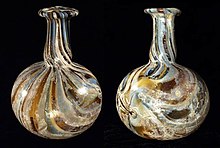Unguentarium
As unguentarium , Balsamarium , Lacrimarium or tears vessel in which is archeology a small Vial or amphorenförmiges ointment jar made of glass or ceramic referred to, which in appearance in about a modern bottle corresponds. Larger vessels are called ampulla unguenti .
Medical or cosmetic ointments or similar substances were usually kept in such vessels. In ancient times, balsamias were often used as grave goods . Related forms of the unguentarium are the Greek aryballos and the alabastron, which originated in Egypt and was adopted in Greece .
The name comes from the Latin word unguentum for ointments , or from balsamum for balms . In the older literature, the popular term ointment can, tear glass or tear bottle (Latin lacrimarium; from lacrima; the tear) was often used. This expression, which has been handed down in research history, was used until the 19th century and goes back to the erroneous assumption that ancient people, mourning their dead, used it to collect the tears they had shed for the deceased and then to give them to the dead man's grave. An interpretation of where this assumption comes from could have been in the deeply rooted Christian faith of the people of the 17th to 19th centuries. Some biblical passages specifically name a tear tube or a tear glass. There is no concrete ancient source for tear vessels.
After this popular name, terracotta bottles a few centimeters high are also named as tear bottles , which are found in large numbers at the Mars Lenus shrine on the Martberg . These vessels were made for purely ritual purposes and had no practical function. They can be hollow or solid and were sacrificed on the Martberg. For this purpose, the tear bottles were smashed by the dedicants .
Not least because of the portrayal of Nero by Peter Ustinov in the monumental film Quo vadis? (“Tigellinus, my tear glass!”) The term tear glass is often used nowadays, especially in the media . Mostly in connection with pictorial (and ironic) reports about tearful or maudlin events, it is then stated, for example, that it would have been advisable to offer a tear glass to collect the tears.
Individual evidence
- ↑ cf. Pit 2014.
- ↑ Claudia Nickel: Gifts to the gods. The Gallo-Roman temple district of Karden (Kr. Cochem-Zell, D) . In: Archeologie et Histoire Romaine. 3, Montagnac 1999, p. 57.
literature
- Christian Grube: Urnae lacrymalis terrea - tear vessels. In: U. Veit , M. Wöhrl (Hrsg.): Donnerkeil - sacrificial knife - tear vessel, the archaeological objects from the collection of the Leipzig pharmacist family Linck (1670–1807) in the natural history cabinet Waldenburg (Saxony). Professorship for Prehistory and Early History, Leipzig 2014, ISBN 978-3-936394-21-4 , pp. 66–69.
- Heinrich Laag : Small dictionary of early Christian art and archeology. Reclam, Stuttgart 1990, ISBN 3-15-008633-7 , p. 241.
Web links
- Balsamarium in the shape of a woman's head: 3D model in bavarikon
- Balsamarium in the shape of a monkey: 3D model in bavarikon
- Ancient perfume , adventure archeology , documentation on Arte ( camphor-based perfume from southern Italy, resin and salt as preservatives, oils, flower extracts still undeveloped, therefore strong smells such as sage, thyme; at the same time shine for the hair; easy filtration)

